The Jenny Burrowes Japanese Garden at Mentone Girls' Grammar, Melbourne
Projects that involve children in learning more about art and culture are inspiring. One such venture took place at the Mentone Girls' Grammar (Melbourne) back in 19991 under the leadership of Jenny Burrowes (Head of Humanities and SOSE2) when a Federal Government grant of $1000 was received from ALSAS - the Asian Languages and Studies in Australian Schools3 program to establish a Japanese Garden within the school grounds.
The School Archivist, Gayle Neylan is keen to promote the garden as it represents the importance of the cultural exchange the school has been involved in with Japan since the early 1970s when the Japanese language was first introduced as a subject. By the mid 1980s a Student Exchange Program with the Seijoh High School in Nagoya had been commenced.1
Established in 1899, Mentone Girls' Grammar is one of the first schools in Melbourne with its history being recorded in Mentone: The Place for a School by Pauline B. Burren, a former Vice Principal at the school.

The idea to construct a Japanese Garden at the school was formed by Jenny Burrowes who along with Marilyn Wiber and the Late Sue Penicuik in the Junior School were members of an Association for Teaching of Asia
across the Curriculum.
In 1985 Jenny Burrowes was not only one of the staff to make the first visit by MGG to the Seijoh High School in Japan but also took gifts and greetings on behalf of the Lord Mayor of Melbourne to Osaka, the Sister City of Melbourne.1
In 1999 (the school's centenary year) Jenny decided to make a permanent place within the school grounds - a Japanese Garden - which would represent the school's cultural exchange with Japan and offer a quiet corner for reflection. Her aim was also to enhance the involvement of students from all years at school and to promote the integration of subjects across the curriculum especially through Art, English, SOSE2 and LOTE5.
A Committee of Year 11 and 8 pupils was established to assist in the project and especially to liaise with the students who were to be encouraged to make one paper crane each to be used in the Opening Ceremony of the Japanese Garden, planned for October 1999. 6
The crane in Japan is one of the mystical or holy creatures and is said to live for a thousand years. In fact an ancient Japanese legend promises that anyone who folds a thousand origami cranes will be granted a wish by the gods.7
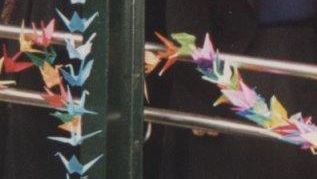
The place between the Founder's Wing and the Science Block within the grounds of MGG was selected for the Japanese Garden and work began to acquire the symbolic elements.
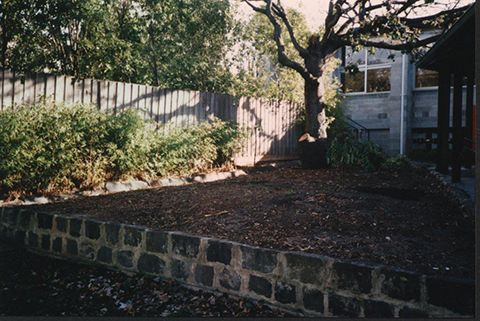
The configuration of the garden was established through the spreading of pebbles which symbolise an element of nature specifically in this case, the sea. In addition, the natural scene was enhanced by the inclusion of three large granite rocks - also elements of nature.
Bamboo is used in a Japanese Garden for its simple beauty. A bamboo screen acts as both a boundary to the configuration of the garden and also to enhance the other elements. Jenny Burrowes designed the large black metal fence to act as a screen. Sam Kakavas, a maintenance/carpenter staff member at MGG whose skill and enthusiasm for the project was vital to Jenny 6 constructed and painted the metal frame. Jenny installed the insert of bamboo using the special Japanese knot tying technique (see below). Jenny also constructed a small bamboo fence to be placed across the front of the garden.
The Japanese maple is closely associated with the country and images frequently appear in Japanese art works. According to Shinto beliefs, spirits—including spirits who live in the trees and the earth—all call Nature their home. For most Japanese, going to view the maple trees (especially when adorned in their autumn colours) is a form of communion with Nature and the spirits who live in it.9
The Japanese Lantern was central to the garden symboling light and being made of granite it also represented a close connection with nature.
A Japanese Garden is a place of reflection therefore the Tsukubai (Crouching bowl) is very significant as it provides a means for visitors to purify themselves by the ritual washing of hands and rinsing of the mouth. Tsukuau means to crouch or to bow down in an act of humility. The supply of water in this garden comes via a bamboo pipe called a Kakei.7
Originally it was planned for the students to make the crouching bowl but firing problems with the school's kiln meant that the bowl had to be purchased. For aesthetic reasons it was matched with the Japanese lantern to retain integrity with garden design.6
The Tsukubai also required electrical wiring, the route of which had to be incorporated into the garden design and construction.6
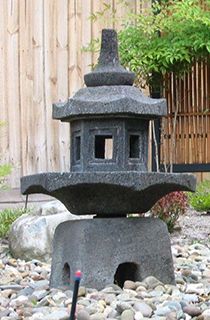
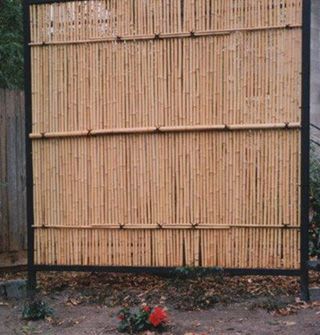
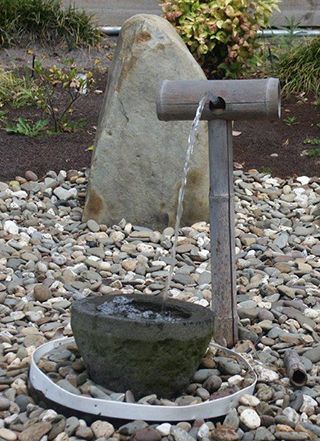
The planting of the Japanese maple tree on the 8 July 1999 saw the commencement of the garden.6
As it was winter the tree has no leaves but you can see it (below) on the left just behind the gentleman in the centre of the image. The pebbles forming the configuration of the garden, enhanced by the large stones with the Tsukubai and Kakei centred because of their significance to the purpose of the garden as explained above.
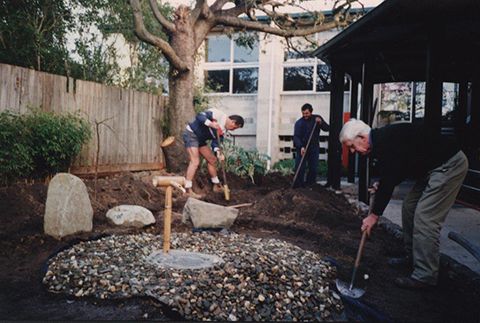
Back in the classroom the making of the paper cranes in origami paper was left to each Form Leader to organise and assist students (following a sheet of instructions) who were not familiar with the process. The Japanese language students were also involved in demonstrating how to make a paper crane. 6
Plants were purchased and some donated to go into the garden: Camellia, Azalea, Baby Tears, Mondo Grass and Nandinas were planted to blend in harmoniously with the design. Finally the bamboo decorative screen and Japanese lantern were added with the screen acting as a boundary to this special place.
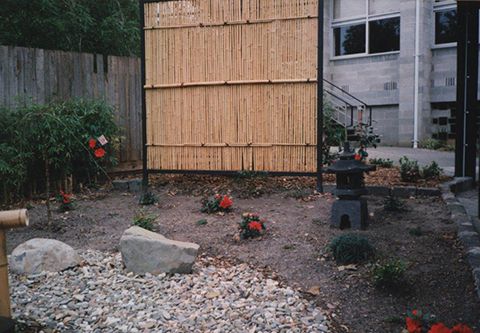
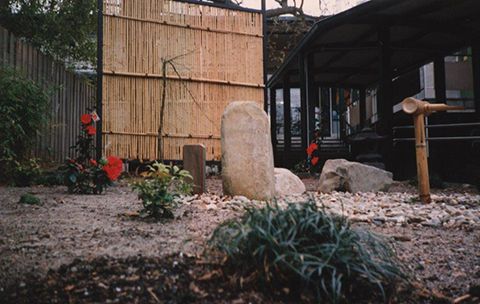
Although Jenny was the driving force behind the creation of the garden, she did receive considerable support and help from the school gardener Alison Dalley and outdoor staff George McKay who were important members of the team.6
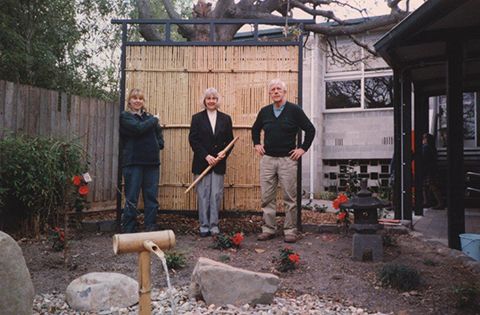
Significantly, five bamboo rods were placed as decoration on the face of the bamboo screen (above and above) being tied in place by Jenny Burrowes and some students using the traditional Japanese twine and tying technique.6
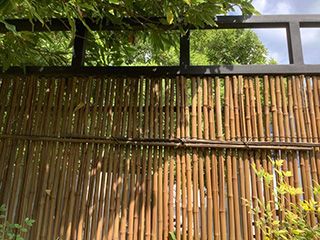
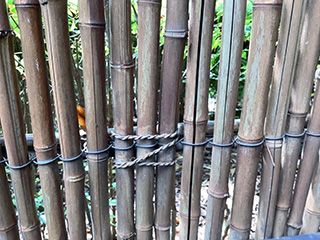
Below we see Jenny Burrowes standing proudly in front of her Japanese Garden created in 1999. Note that the bamboo fence at the front of the garden was also constructed by Jenny using the traditional Japanese tying technique which was much admired by the staff from the visiting Japanese schools.
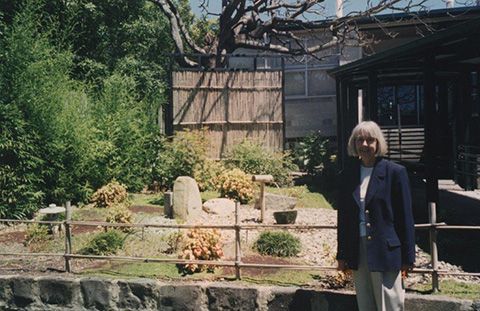
It is also important to note how much the creation of the Japanese Garden was enjoyed by everyone - from visitors such as relatives on Grandparents Day to the staff and students walking to the Science block throughout the day appreciating how the new garden linked to the Willow Courtyard and environs harmoniously. And importantly students were keen to learn about the significance of the features. The Student Committee who had been involved since the start were congratulated by Jenny for their contribution.6
A particularly delightful reaction was included in Jenny's diary notes - from a group of Year 2 students who said: We could keep a panda in our garden and save a life! 6
Therefore central to this project was the involvement of the students and not only those at MGG - visiting Japanese students from the Kinjo Gakuin High School in August 1999 were also involved in the final planting out of the plants and in demonstrating how to make origami cranes, adding their own to the growing collection. 6
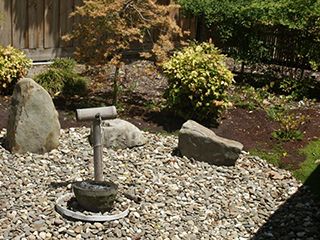
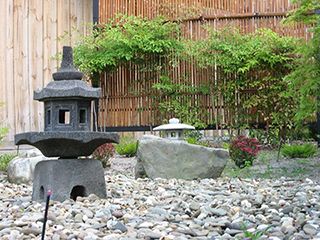
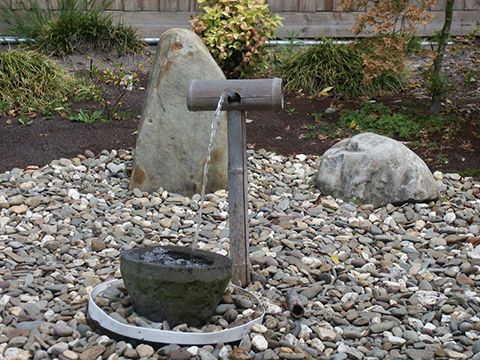
The Jenny Burrowes Japanese Garden was officially opened by Mr Masaki Ishida, Principal Seijoh High School, Nagoya Japan on 22 October 1999.
The Term 4 opening ensured a Spring event to maximise the beauty of the garden with the flowering of the Camellias and Azaleas and Japanese Maple.
Hundreds of small paper cranes made by all History, Japanese and Geography classes plus Prep - Year 6 classes, each bearing on the wings the initials of the student who made it, were hung for the Opening Ceremony. The Student Committee worked hard to create a Japanese festival atmosphere to enhance the importance of the garden. 6
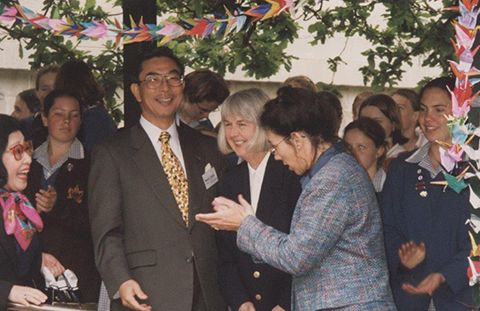
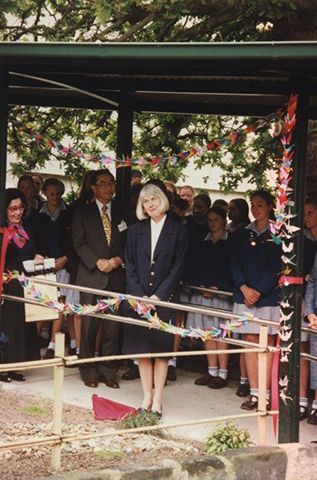
Jenny Burrowes reported with pride that the visitors were especially impressed by our ability to tie the bamboo screen and fence using traditional methods and twine ...and the accuracy in the placement of plants, rocks and water.1
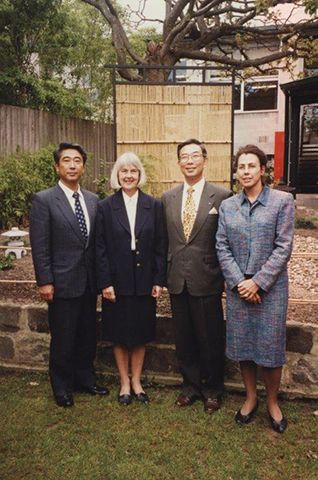
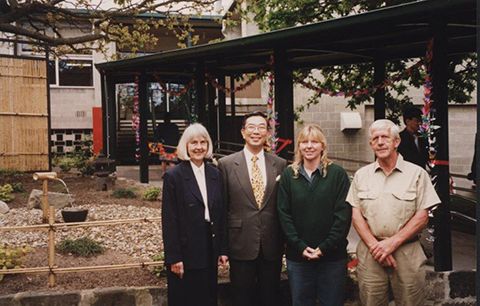
Two additional elements were added to the garden on Opening Day when gifts of a valuable Traditional Japanese Stone Garden Temple and large stone (as seen below) were donated by Mr Masaki Ishida, Principal Seijoh High School, Nagoya, Japan.
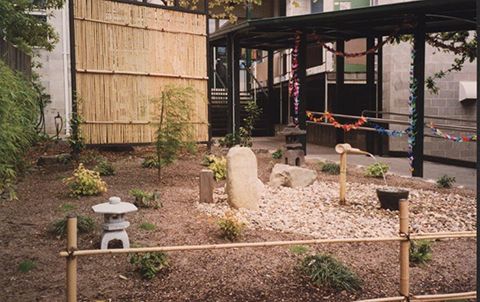
The Opening of the Japanese Garden was also attended by students from the Seijoh High School, Nagoya Japan. And what a wonderful experience it would have been for these children to see a garden created in recognition of the importance of their culture to Mentone Girls' Grammar.
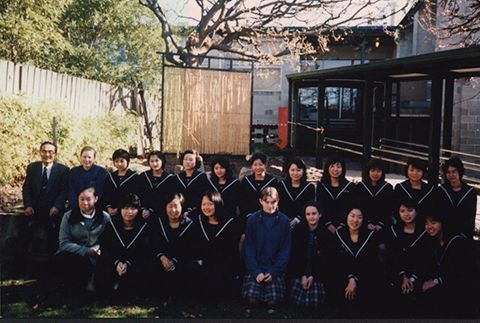
The project taught the students many new skills, understandings and appreciation of another culture. As Jenny Burrowes wrote back in 1999:
Despite its infancy, the garden promises much in the future as a small space of beauty, harmony and balance of natural features. Its also displays ingenuity and collaborative teamwork between three staff members (one teacher and two outdoor staff ) and an enthusiastic student committee. Their commitment attracted others who offered help in many small ways to ensure the project would be finished and support the longterm curriculum aims for it.
The natural elements and spiritual links of Japanese Garden design has afforded the students a new way of thinking of their own surroundings at home and at school...Focus on the Garden has promoted a wide recognition of the links between topics across the curriculum already undertaken within the School at both Junior and Senior levels. Mentone Girls' Grammar is an Asia literate School, but visible and longterm projects such as the garden highlight regional and cultural similarities and provide an effective way to understand cultural differences. 6
Most significantly, as stated on the plaque in the garden, Jenny Burrowes and the creation of the Japanese Garden taught the students that:
A dream becomes reality.
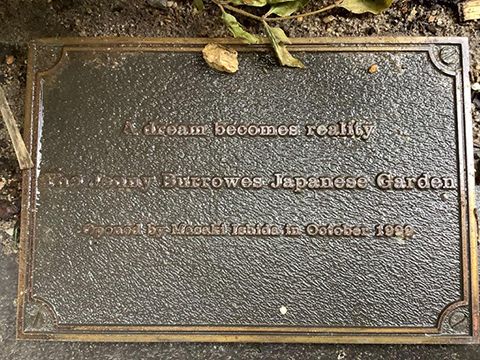
Sadly the Jenny Burrowes Japanese Garden at Mentone Girls' Grammar is no longer in its original state as the plants suffered badly during the long drought and water restrictions experienced in Victoria during the decade following its creation.
Whilst the garden is still aesthetically pleasing, the traditional Japanese features are no longer in focus. It would be wonderful to see the garden returned to its original plan and once more Mentone Girls' Grammar could enjoy the beauty and cultural significance of The Jenny Burrowes Japanese Garden.
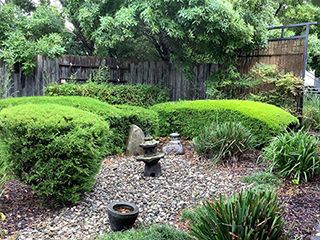
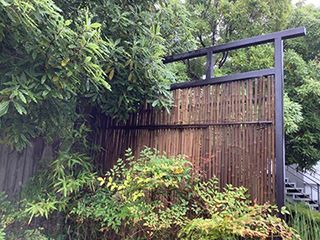
The school has received many beautiful and expensive gifts from their association with the Japanese School since the 1980s. In a post to follow we will present these to you, including a wedding kimono and koto (stringed instrument).
Thank you to Gayle Neylan, Archivist, Mentone Girls' Grammar who provided the information and images and assisted in the presentation of the post.
Permission for the images to be shared on the AnArt4Life blog was provided by the Mentone Girls' Grammar.
Thank you to Jenny Burrowes for her assistance in presenting the background information.
Jenny's connection with Mentone Girls' Grammar began as a student when she was four years old. In the following years she became a teacher, parent, School Archivist and active member of the Old Girls' Club. Jenny was a member of Staff for 24 years. She has been a wonderful mentor to Gayle, with her incredible knowledge of the School and its Community. Her love of, and interest in, the School continues to this present day, being an avid attendee at reunions and functions.
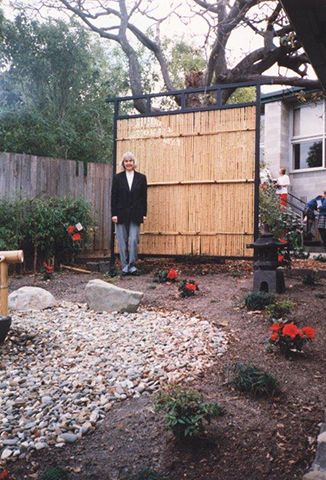
Footnotes
1. Information provided by Gayle Neylan, Archivist, Mentone Girls' Grammar, Melbourne, Victoria, Australia
2. SOSE-Studies of Society and Environment
3. ALSAS- Asian Languages and Studies in Australian Schools was a school-based program to cover the Years 3-10 and Years 11-12 languages and
cultures studies implemented in 1994 by National Asian Languages & Cultures
Working Group commissioned by the Council of Australian Governments (COAG).
4. Mentone: The Place for a School by Pauline B. Burren. Published by Hyland House, South Yarra, Victoria, 1984 Image credit: library.mentonegirls.vic.edu.au/school-timeline
5. LOTE- Languages other than English
6. Diary entries and correspondence for the construction of the Japanese Garden at MGG 1999 by Jenny Burrowes
7. en.wikipedia.org
8. Image provided from Mentone Girls' Grammar Archives
9. dengarden.com
